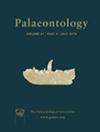温度大小规则的例外:来自伊朗西北部阿拉斯山谷的二叠纪末介形类(甲壳类)没有利力浦特效应
IF 2.3
2区 地球科学
Q1 PALEONTOLOGY
引用次数: 0
摘要
海洋变温动物的体型通常与环境水温呈负相关,正如在二叠纪末大灭绝(约252 Ma)的过热危机期间的许多进化枝中所看到的那样。然而,对于介形虫来说,在古代高温事件中的大小变化很少被量化。本研究从类、目、种三个分类水平对伊朗西北部阿拉斯河谷地区介形虫的体型变化进行了评估,以响应二叠纪末大灭绝期间的剧烈变暖。在物种组合水平上,气候变暖引发了阿拉斯山谷剖面的物种更替,在短时间内,较大的新出现物种主导了灭绝后的物种组合。在二叠纪末危机期间,个体介形类和星类没有表现出侏儒化或体型变化,以适应温度压力。这可能表明,阿拉斯山谷剖面的介形类可能是温度-尺寸规则(TSR)的例外,它们使用的适应机制不涉及体型的减小。这种适应可能类似于在最近的一些关于介形虫对热应激反应的实验研究中可以观察到的加速发育,尽管它们的龄体大小不变。本文章由计算机程序翻译,如有差异,请以英文原文为准。
Exceptions to the temperature–size rule: no Lilliput Effect in end‐Permian ostracods (Crustacea) from Aras Valley (northwest Iran)
The body size of marine ectotherms is often negatively correlated with ambient water temperature, as seen in many clades during the hyperthermal crisis of the end‐Permian mass extinction (c. 252 Ma). However, in the case of ostracods, size changes during ancient hyperthermal events are rarely quantified. In this study, we evaluate the body size changes of ostracods in the Aras Valley section (northwest Iran) in response to the drastic warming during the end‐Permian mass extinction at three taxonomic levels: class, order, species. At the assemblage level, the warming triggers a complete species turnover in the Aras Valley section, with larger, newly emerging species dominating the immediate post‐extinction assemblage for a short time. Individual ostracod species and instars do not show dwarfing or a change in body size as an adaptation to the temperature stress during the end‐Permian crisis. This may indicate that the ostracods in the Aras Valley section might have been exceptions to the temperature–size rule (TSR), using an adaptation mechanism that does not involve a decrease in body size. This adaptation might be similar to the accelerated development despite constant instar body sizes that can be observed in some recent experimental studies of ostracod responses to thermal stress.
求助全文
通过发布文献求助,成功后即可免费获取论文全文。
去求助
来源期刊

Palaeontology
地学-古生物学
CiteScore
5.60
自引率
3.80%
发文量
43
审稿时长
6 months
期刊介绍:
Palaeontology publishes a wide variety of papers on palaeontological topics covering:
palaeozoology
palaeobotany
systematic studies
palaeoecology
micropalaeontology
palaeobiogeography
functional morphology
stratigraphy
taxonomy
taphonomy
palaeoenvironmental reconstruction
palaeoclimate analysis and biomineralization studies.
 求助内容:
求助内容: 应助结果提醒方式:
应助结果提醒方式:


